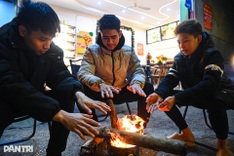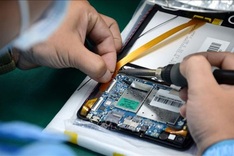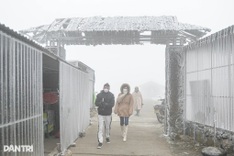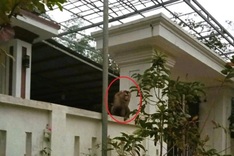
Every year during the rainy season, Trần Thị Thanh Linh's family in Thủ Đức City in HCM City suffers from rove beetles.
"Almost every year, our family gets dermatitis due to the toxin of rove beetles. Some years, all three members of my family are affected. Mild cases result in small areas of dermatitis that usually clear up in about 10 to 14 days with topical treatment. However, last year my husband had a severe case with widespread dermatitis and high fever, and he had to be hospitalised," Linh recounted.
She added that not only her family but many residents in her apartment building have also been attacked by rove beetles.
Bringing her son to the HCM City Dermatology Hospital, Phạm Ngọc Loan, a resident of an apartment building in District 8, said that recently, there have been many rove beetles in her home.
She shared, "My son thought they were normal ants and killed them with his bare hands. Without realising it, he then touched his face. The next morning, his eyes were swollen, filled with pus, and red, with blisters on his ears. We tried over-the-counter medication, but it didn't help, so I brought him to the hospital."
Dr Phạm Thị Uyển Nhi, deputy head of the General Planning Department at HCM City Dermatology Hospital, stated that recently, the hospital has received many cases of contact dermatitis due to rove beetles.
On average, 50-70 cases are treated daily.
“Many patients arrive in a severe condition after trying folk remedies or seeking treatment at unreliable facilities, which leads to secondary infections and worsens the condition,” the doctor said.
In fact, many people confuse the symptoms of shingles with contact dermatitis caused by rove beetles, as they have similar characteristics.
According to the doctor, the rainy season's temperature and humidity create favourable conditions for rove beetles to reproduce and thrive. Rove beetles prefer dry places, so during the rainy season, they tend to enter homes.
The pederin toxin in rove beetles can cause blisters and varying degrees of dermatitis, from mild to severe. The condition can spread if the wound is not properly cared for or scratched.
To minimise the toxin of rove beetles, people should first wash the affected area with water gently, without rubbing too hard, to remove as much of the beetle's toxin as possible.
People should also avoid scratching, rubbing, or breaking the blisters caused by rove beetles as it can inadvertently spread the toxin and worsen the condition.
If large blisters and spreading lesions appear, they should visit a hospital or specialist for specific oral and topical medications.
Nhi also said that when affected by the toxin of rove beetles, people should not apply leaves, homemade remedies, or unknown medications. This not only fails to improve the condition but can also worsen the dermatitis, potentially leading to infection and more extensive lesions.
Rove beetles are particularly attracted to electric lights, especially fluorescent lights.
Doctors recommend that during the rainy season, residents should install insect screens, reduce indoor lighting to avoid attracting rove beetles, and keep their homes clean, especially areas where insects can hide, such as door crevices and damp corners.
Locals should avoid drying clothes outdoors at night to help prevent rove beetles from entering homes as well.




















